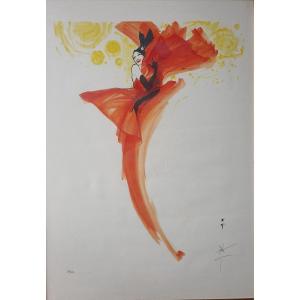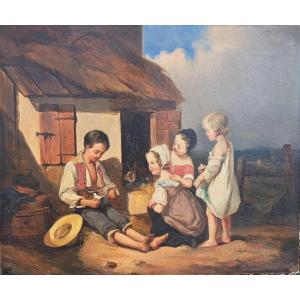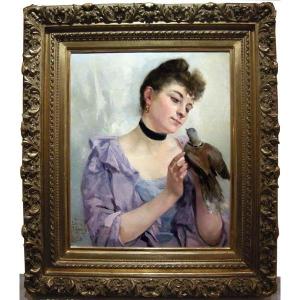One finds in the foreground around a table peasants with very expressive faces, almost caricatural.
One of them smokes the pipe, the decor testifies to the interior of a Dutch tavern of the seventeenth century: wooden table (on which rests a leaf in balance), barrel turned over as a seat.
On the ground different elements are present as playing cards, a jug (we find these same elements in the works of the artist).
In the background (on the right) we notice a little girl with a dog, then a man back.
This 17th century work is painted on oak panel.
Unsigned, this painting is closer to the works of the painter Adriaen Brouwer.
The pictorial style and the various elements present in this painting fill all the codesof the painter. An attribution is in my opinion more than likely.
This museum piece is in very good condition, has very slight scales at the bottom, as well as some old spots.
It is sold with a golden wooden frame that suits it perfectly.
Panel size: 34 x 29 cm
Frame dimensions: 50 x 45 cm
Andriaen Brouwer (Oudenaarde 1605 or 1606 – Antwerp 1638).
It seems to be in 1622 in Antwerp and in 1625 in Amsterdam. In 1628 he entered the workshop of Frans Hals in Haarlem; he returned to Antwerp in 1631 and now settled there. His works are not easy to identify, none being signed, only a few bearing his monogram. The criticism agrees however to attribute it approx. 80 paintings and some drawings. Works from the Dutch period are distinguished from those from the Flemish period, the first still revealing a distant influence of Pieter Bruegel the Old. An Inn Interior (Rotterdam, B. V. B.), a Beuverie paysanne (Mauritshuis), the Smokers (Kassel Museum) show caricatural characters, but true, animated by a vivacity still quite Flemish. Back in Antwerp, the painter multiplied heads of expression, such as the Tête de paysan (Oosterbeek, coll. part.), the Man with a pointed hat (Rotterdam, B. V. B.) or his self-portrait (Mauritshuis). He borrows from Holland another atmosphere, imbued with a chiaroscuro that gives his paintings a new depth: so for Tabagie (Louvre), the Players of dice fighting (Dresden, Gg), the Operation at the foot (Aachen Museum). He then begins to express himself through the landscape, associating nature with human activities, while twilight, night and tragedy attract him. In the Moonlight Landscape (Berlin Museums), the Open Air Drinkers (Madrid, Thyssen-Bornemisza Foundation), the Twilight Landscape (Louvre), a miserable humanity presented in an intense shortcut merges into landscapes that glacis, the density of matter, The large invoice, attached in places to a delicate touch, charge with a sinister and romantic poetry. Held in high esteem in his time (Rubens owned 17 of his paintings and Rembrandt 8). The most beautiful series of his paintings, preserved in Munich, is an almost unbearable pessimism, reminiscent of Bosch or Bruegel. The grimacing and monstrous characters, locked within the limits of a tavern, know that they can not escape this closed world, seat of fights and sordid fights.... In rare paintings, a child appears, messenger of hope? Such a universe, carrying such a great intensity of experience, was inimitable. David Téniers takes up his already very modern conception of the landscape, while Dutch like I. Van Ostade, H. M. Sorgh, P. Bloot, or Flemish like J. Van Craesbeck, D. Ryckaert III, D. Téniers le Jeune are inspired by his genre paintings.
The photos are taken in natural light.
Neat packaging.
Shipping costs at the expense of the buyer.
I remain at your disposal for any additional information and photos.

























 Le Magazine de PROANTIC
Le Magazine de PROANTIC TRÉSORS Magazine
TRÉSORS Magazine Rivista Artiquariato
Rivista Artiquariato
